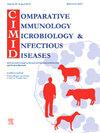关于巴基斯坦水蚤分子流行病学以及寄生虫遗传多样性和种群结构全球概览的主要报告。
IF 2
3区 农林科学
Q4 IMMUNOLOGY
Comparative Immunology Microbiology and Infectious Diseases
Pub Date : 2024-10-01
DOI:10.1016/j.cimid.2024.102248
引用次数: 0
摘要
由水蚤(T. hydatigena)幼虫引起的囊尾蚴病是一种备受兽医关注的疾病,它给全球畜牧业造成了重大经济损失。虽然牲畜是巴基斯坦经济中最具生产力的部分,但对水囊虫的流行病学流行率和遗传多样性却没有进行过详细研究。目前的研究是为了估算 T. hydatigena 在巴基斯坦南旁遮普省木尔坦的山羊和绵羊中的流行率和遗传多样性。以 T. hydatigena 的细胞色素 c 氧化酶亚单位 1 (cox1) 基因为目标的 PCR 方案显示,小型反刍动物中的总体流行率为 31.33%,其中雌性(40.86%)和年龄大于 3-≤5 岁年龄组(40.74%)的流行率较高。共对 30 个分离株的线粒体 cox1 部分基因进行了测序,得出了 12 个单倍型,单倍型多样性为 0.798 ± 0.68,核苷酸多样性为 0.0046 ± 0.00183。单倍型网络呈星形结构,单倍型位于中心位置。中性指数(如 Tajima's D 和 Fu's Fs)也偏向于阴性,这一特征表明寄生虫种群正在扩大。此外,我们还对 NCBI GenBank 上的部分 cox1 基因序列计算了 T. hydatigena 的遗传多样性。共检索到 415 个序列,其中确定了 142 个单倍型,单倍型多样性为 0.9150 ± 0.012,核苷酸多样性为 0.00830 ± 0.00043。T. hydatigena 种群的单倍型特征显示缺乏中心单倍型,但遗传变异相当大。除非洲外,所有种群的单倍型多样性都很高(>0.9),但在少数种群中观察到较高的 Fst 值,这说明中亚/东亚、中东、欧洲和南亚种群之间的基因流动有限。本文章由计算机程序翻译,如有差异,请以英文原文为准。
Leading report regarding the molecular epidemiology of Taenia hydatigena from Pakistan and global overview of the genetic diversity and population structure of the parasite
Cysticercosis, caused by larval stage of Taenia (T.) hydatigena is a disease of veterinary concern which causes major economic losses in livestock sector globally. Although livestock is the most productive part of Pakistan’s economy, the epidemiological prevalence and genetic diversity of T. hydatigena has not been studied in great detail. Current study was undertaken for the estimation of the prevalence and genetic diversity of T. hydatigena among the goats and sheep of Multan in South Punjab, Pakistan. A PCR protocol targeting the cytochrome c oxidase subunit 1 (cox1) gene of T. hydatigena revealed an overall prevalence of 31.33 % among the small ruminants with higher prevalence in females (40.86 %) and older age group of >3-≤5 years (40.74 %). A total of 30 isolates were sequenced for partial mitochondrial cox1 gene which yielded 12 haplotypes with a haplotype diversity of 0.798 ± 0.68 and nucleotide diversity of 0.0046 ± 0.00183. A star like configuration was demonstrated in the haplotype network with a centrally positioned haplotype. Neutrality indices like Tajima’s D and Fu’s Fs were also biased towards negativity, a characteristic which suggests an expanding parasitic population. Moreover, the genetic diversity of T. hydatigena was also computed for the partial cox1 gene sequences available on GenBank, NCBI. A total of 415 sequences were retrieved out of which 142 haplotypes were identified having a haplotype diversity of 0.9150 ± 0.012 coupled with a nucleotide diversity of 0.00830 ± 0.00043. The haplotype profile of T. hydatigena population displayed an absence of a central haplotype, however, considerable genetic variation was ascertained. All the populations except Africa had a high haplotype diversity (>0.9), however, high Fst values were observed for a few populations which elucidated limited gene flow among the populations of Central/East Asia, Middle East, Europe and South Asia.
求助全文
通过发布文献求助,成功后即可免费获取论文全文。
去求助
来源期刊
CiteScore
4.60
自引率
0.00%
发文量
102
审稿时长
40 days
期刊介绍:
Comparative Immunology, Microbiology & Infectious Diseases aims to respond to the concept of "One Medicine" and to provide a venue for scientific exchange. Based on the concept of "Comparative Medicine" interdisciplinary cooperation between specialists in human and animal medicine is of mutual interest and benefit. Therefore, there is need to combine the respective interest of physicians, veterinarians and other health professionals for comparative studies relevant to either human or animal medicine .
The journal is open to subjects of common interest related to the immunology, immunopathology, microbiology, parasitology and epidemiology of human and animal infectious diseases, especially zoonotic infections, and animal models of human infectious diseases. The role of environmental factors in disease emergence is emphasized. CIMID is mainly focusing on applied veterinary and human medicine rather than on fundamental experimental research.

 求助内容:
求助内容: 应助结果提醒方式:
应助结果提醒方式:


